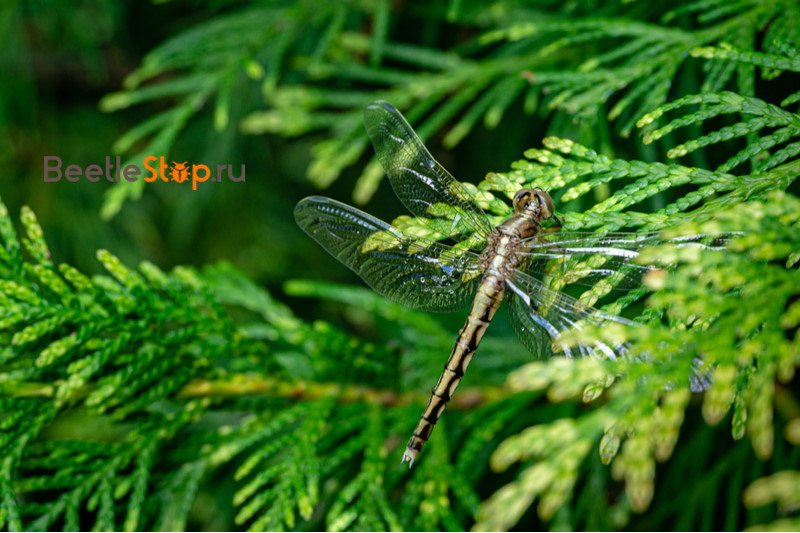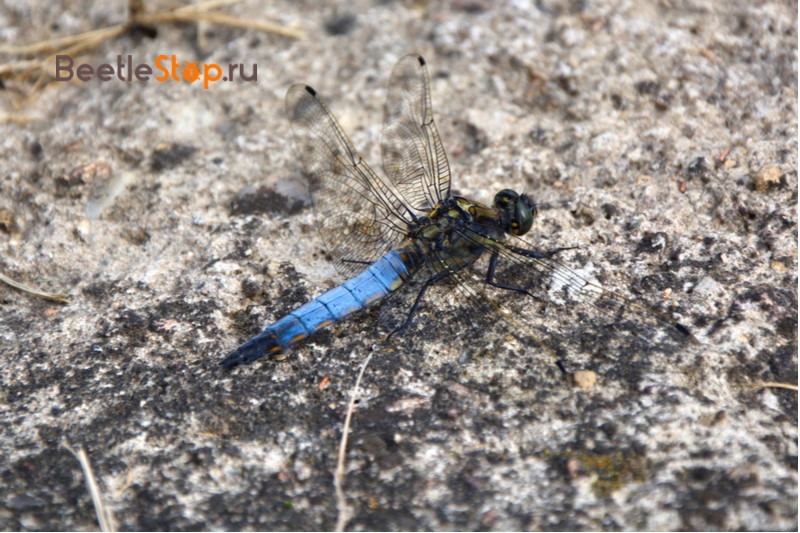Trellis dragonfly - a large representative of the genus Ortetrum
Straight bellies are one of the six genera of the family true dragonflies. They are distributed throughout Europe, live in Asia. Of the 80 existing species, medium-sized dragonflies with brown, yellow, and blue coloration are found in Russia. The trellis dragonfly is the largest insect, its body length reaches 50 mm, and its wingspan is 90 mm. They are characterized by sexual dimorphism, the male is easily distinguished by the bright blue abdomen. Offspring develops in stagnant water bodies filled with vegetation.
Morphological description of the species
Dragonfly trellis (Orthetrum cancellatum) belongs to the family of real dragonflies, the genus of straight-bellied. A popular insect has many synonyms for its name - a large blue dragonfly, a straight-bellied trellis, an orthotrum ordinary. Slender adults with a long, moderately flattened abdomen grow to 45-50 mm. The main part of the head is occupied by huge faceted eyes. Two bright spheres consisting of thousands of small eyes provide dragonflies with excellent vision. They do not have to rely on short and weak antennae for food.

Information. The female of the common ortetrum has brown antennae and the male blue.
The common color scheme is yellowish or brownish with longitudinal dark stripes on the segments of the abdomen. Males and females of young straight-bellies look the same, but with age, the abdomen of males turns blue due to wax coating. Only the last two segments remain black.
Insects have two pairs of elongated transparent wings with a thin tangled venation pattern. Base without dark spots, pterostigma black. During rest, the wings are directed to the sides and slightly shifted forward. The wingspan is 80-90 mm. The limbs are dark, black or brown.
Information. The straight-belly is called the ethmoid for the characteristic pattern of black stripes on the yellow abdomen.
Habitat
The view of the common orthotrum is well known to residents of Europe and Asia. Dragonflies live throughout the European continent, the northern border of the range passes through Finland and the UK. The species settled far to the east; it is found in the Caucasus, Central and Central Asia, southern Siberia, Mongolia, India, and the northern provinces of China. Almost throughout the habitat, the number of insects is stable.
Information. Trellis dragonfly is listed in the Red Book of the Tyumen Region.

Lifestyle & Typical Habitats
Summer time is directly belly ethmoid from May to the end of the summer period. Insects prefer reservoirs with stagnant water (lakes, ponds) or slow flow - rivers, canals. Damselfly dragonflies are the best flyers and hunters. Fast and fast predators catch butterflies, mosquitoes and other prey on the fly. They significantly reduce the number of harmful insects. Females are more secretive and circumspect, therefore males can be observed more often. They fly low above land and water, controlling a divided territory. Adults often rest on stones and open areas of land.
Orthetrums love warmth, on a sunny, hot day they can be seen flying over water in pursuit of mosquitoes and midges.Periodically, dragonflies sit down to relax on a reed or branch. In cold inclement weather, insects are lethargic and passive, hiding under the leaves.
Orthrum larva
Female dragonflies of the ethmoid do not have an ovipositor; they drop offspring into the water on the fly, hitting the abdomen with water. Eggs sink to the bottom, where they lie during the entire incubation period - 4-5 weeks. Larvae burrow into bottom sediments. They lead a secretive lifestyle, hide among the vegetation, hunt from ambush. With the help of a special mask organ, the progeny of a straight-bellied hunt for aquatic invertebrates - daphnia, water donkeys, mosquito larvae. In addition, they scoop up silt and detritus with a mask and choose everything suitable for food.
The body of the larvae is massive, expanded in the middle part of the abdomen, covered with hairs. Adult nymphs grow to 23-25 mm. The head is small, the eyes occupy no more than 1/3 of its length. The antennae consist of 7 segments. The abdomen from 3 to 6 segments is covered with dorsal spines. The limbs are thick, the rear are the longest. Breathing is through the anus. Inside the intestine there are gill outgrowths. When the reservoirs dry, they can breathe atmospheric air. The spiracles in the front of the body are adapted for this.
The release of young dragonflies from the skins of an adult larva occurs on land early in the morning. The nymph climbs a stone or branch, where it freezes in anticipation of cracking of the skin. The selected dragonfly needs to spread its wings for several hours and wait until the chitin covers completely harden.

